Report: Financial Performance Analysis of Telstra Corporation Limited
VerifiedAdded on 2022/05/11
|12
|2396
|51
Report
AI Summary
This report provides a detailed financial analysis of Telstra Corporation Limited, evaluating its performance over the financial years 2017 and 2018. The analysis utilizes ratio analysis techniques, drawing data from Telstra's annual reports to assess key financial aspects. The report examines profita...

1
Financial Analysis of Telstra Corporation Limited
Financial Analysis of Telstra Corporation Limited
Paraphrase This Document
Need a fresh take? Get an instant paraphrase of this document with our AI Paraphraser
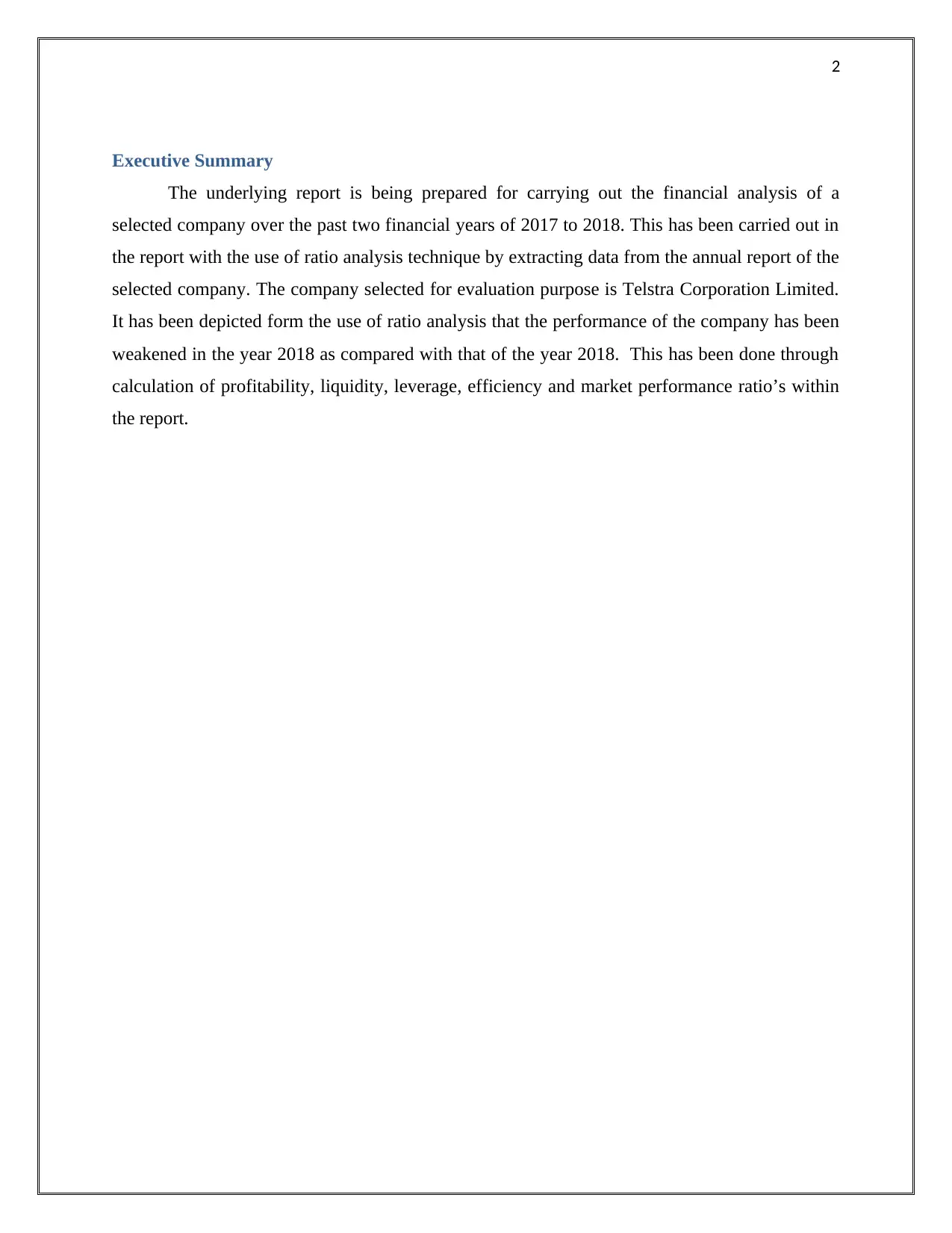
2
Executive Summary
The underlying report is being prepared for carrying out the financial analysis of a
selected company over the past two financial years of 2017 to 2018. This has been carried out in
the report with the use of ratio analysis technique by extracting data from the annual report of the
selected company. The company selected for evaluation purpose is Telstra Corporation Limited.
It has been depicted form the use of ratio analysis that the performance of the company has been
weakened in the year 2018 as compared with that of the year 2018. This has been done through
calculation of profitability, liquidity, leverage, efficiency and market performance ratio’s within
the report.
Executive Summary
The underlying report is being prepared for carrying out the financial analysis of a
selected company over the past two financial years of 2017 to 2018. This has been carried out in
the report with the use of ratio analysis technique by extracting data from the annual report of the
selected company. The company selected for evaluation purpose is Telstra Corporation Limited.
It has been depicted form the use of ratio analysis that the performance of the company has been
weakened in the year 2018 as compared with that of the year 2018. This has been done through
calculation of profitability, liquidity, leverage, efficiency and market performance ratio’s within
the report.
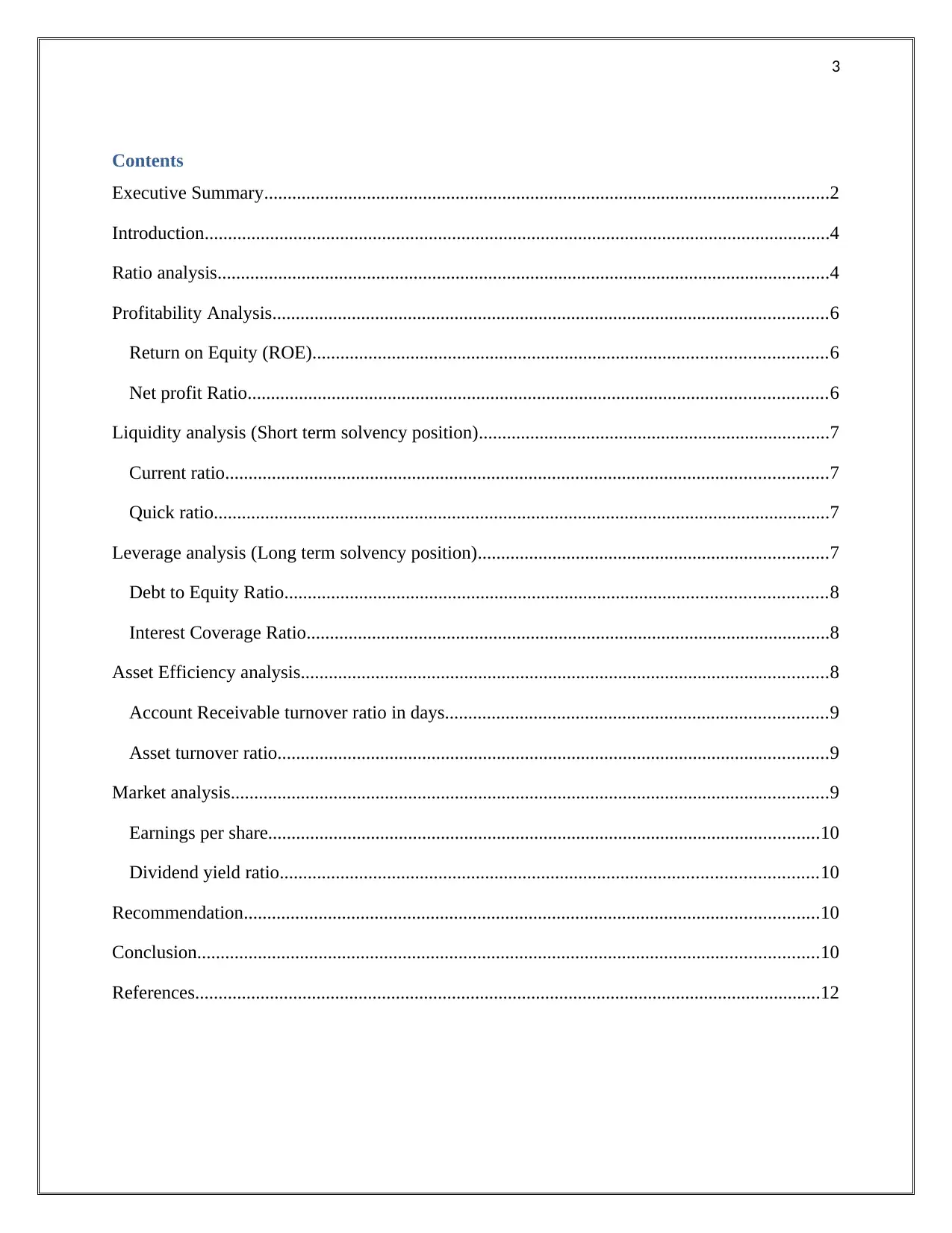
3
Contents
Executive Summary.........................................................................................................................2
Introduction......................................................................................................................................4
Ratio analysis...................................................................................................................................4
Profitability Analysis.......................................................................................................................6
Return on Equity (ROE)..............................................................................................................6
Net profit Ratio............................................................................................................................6
Liquidity analysis (Short term solvency position)...........................................................................7
Current ratio.................................................................................................................................7
Quick ratio....................................................................................................................................7
Leverage analysis (Long term solvency position)...........................................................................7
Debt to Equity Ratio....................................................................................................................8
Interest Coverage Ratio................................................................................................................8
Asset Efficiency analysis.................................................................................................................8
Account Receivable turnover ratio in days..................................................................................9
Asset turnover ratio......................................................................................................................9
Market analysis................................................................................................................................9
Earnings per share......................................................................................................................10
Dividend yield ratio...................................................................................................................10
Recommendation...........................................................................................................................10
Conclusion.....................................................................................................................................10
References......................................................................................................................................12
Contents
Executive Summary.........................................................................................................................2
Introduction......................................................................................................................................4
Ratio analysis...................................................................................................................................4
Profitability Analysis.......................................................................................................................6
Return on Equity (ROE)..............................................................................................................6
Net profit Ratio............................................................................................................................6
Liquidity analysis (Short term solvency position)...........................................................................7
Current ratio.................................................................................................................................7
Quick ratio....................................................................................................................................7
Leverage analysis (Long term solvency position)...........................................................................7
Debt to Equity Ratio....................................................................................................................8
Interest Coverage Ratio................................................................................................................8
Asset Efficiency analysis.................................................................................................................8
Account Receivable turnover ratio in days..................................................................................9
Asset turnover ratio......................................................................................................................9
Market analysis................................................................................................................................9
Earnings per share......................................................................................................................10
Dividend yield ratio...................................................................................................................10
Recommendation...........................................................................................................................10
Conclusion.....................................................................................................................................10
References......................................................................................................................................12
⊘ This is a preview!⊘
Do you want full access?
Subscribe today to unlock all pages.

Trusted by 1+ million students worldwide
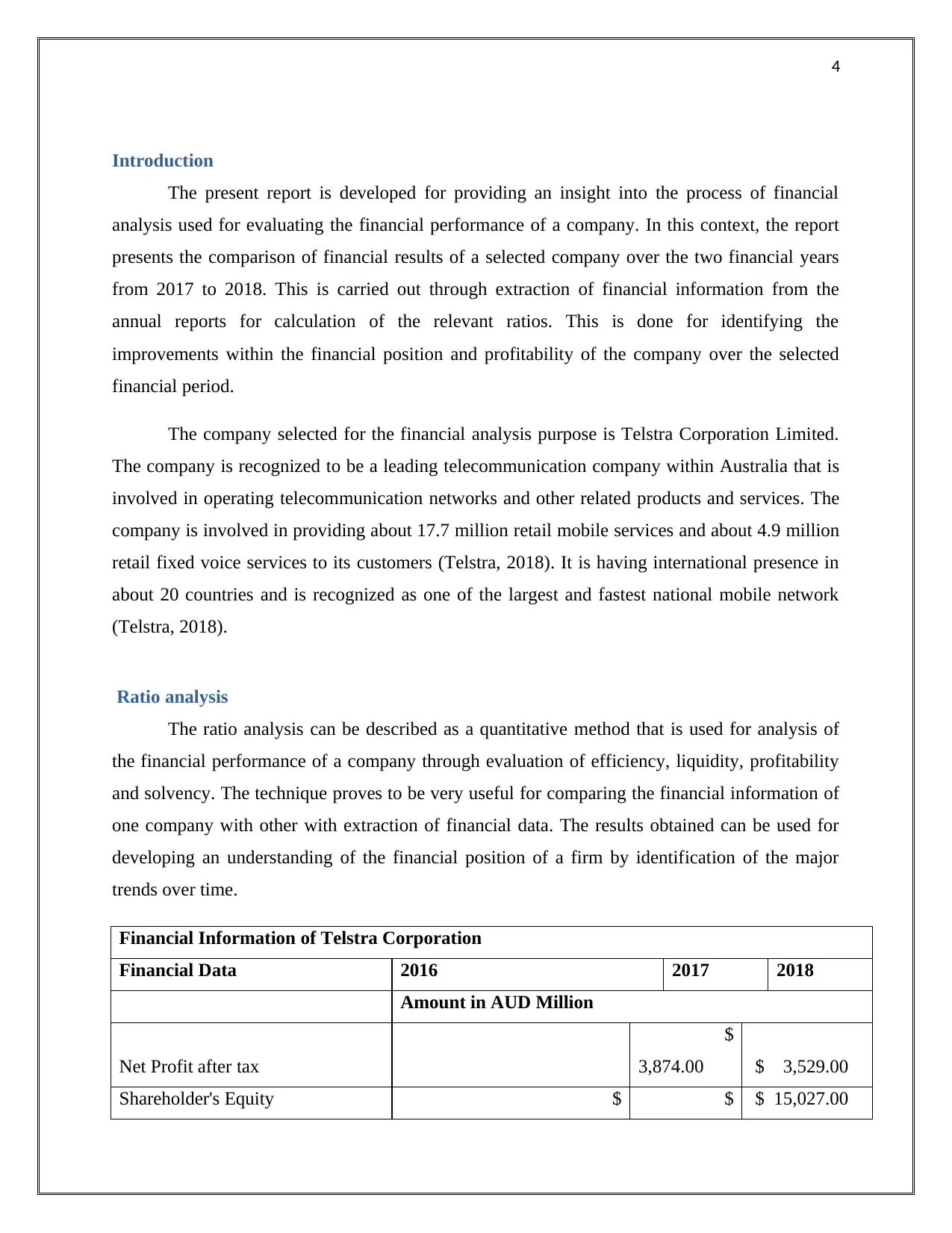
4
Introduction
The present report is developed for providing an insight into the process of financial
analysis used for evaluating the financial performance of a company. In this context, the report
presents the comparison of financial results of a selected company over the two financial years
from 2017 to 2018. This is carried out through extraction of financial information from the
annual reports for calculation of the relevant ratios. This is done for identifying the
improvements within the financial position and profitability of the company over the selected
financial period.
The company selected for the financial analysis purpose is Telstra Corporation Limited.
The company is recognized to be a leading telecommunication company within Australia that is
involved in operating telecommunication networks and other related products and services. The
company is involved in providing about 17.7 million retail mobile services and about 4.9 million
retail fixed voice services to its customers (Telstra, 2018). It is having international presence in
about 20 countries and is recognized as one of the largest and fastest national mobile network
(Telstra, 2018).
Ratio analysis
The ratio analysis can be described as a quantitative method that is used for analysis of
the financial performance of a company through evaluation of efficiency, liquidity, profitability
and solvency. The technique proves to be very useful for comparing the financial information of
one company with other with extraction of financial data. The results obtained can be used for
developing an understanding of the financial position of a firm by identification of the major
trends over time.
Financial Information of Telstra Corporation
Financial Data 2016 2017 2018
Amount in AUD Million
Net Profit after tax
$
3,874.00 $ 3,529.00
Shareholder's Equity $ $ $ 15,027.00
Introduction
The present report is developed for providing an insight into the process of financial
analysis used for evaluating the financial performance of a company. In this context, the report
presents the comparison of financial results of a selected company over the two financial years
from 2017 to 2018. This is carried out through extraction of financial information from the
annual reports for calculation of the relevant ratios. This is done for identifying the
improvements within the financial position and profitability of the company over the selected
financial period.
The company selected for the financial analysis purpose is Telstra Corporation Limited.
The company is recognized to be a leading telecommunication company within Australia that is
involved in operating telecommunication networks and other related products and services. The
company is involved in providing about 17.7 million retail mobile services and about 4.9 million
retail fixed voice services to its customers (Telstra, 2018). It is having international presence in
about 20 countries and is recognized as one of the largest and fastest national mobile network
(Telstra, 2018).
Ratio analysis
The ratio analysis can be described as a quantitative method that is used for analysis of
the financial performance of a company through evaluation of efficiency, liquidity, profitability
and solvency. The technique proves to be very useful for comparing the financial information of
one company with other with extraction of financial data. The results obtained can be used for
developing an understanding of the financial position of a firm by identification of the major
trends over time.
Financial Information of Telstra Corporation
Financial Data 2016 2017 2018
Amount in AUD Million
Net Profit after tax
$
3,874.00 $ 3,529.00
Shareholder's Equity $ $ $ 15,027.00
Paraphrase This Document
Need a fresh take? Get an instant paraphrase of this document with our AI Paraphraser
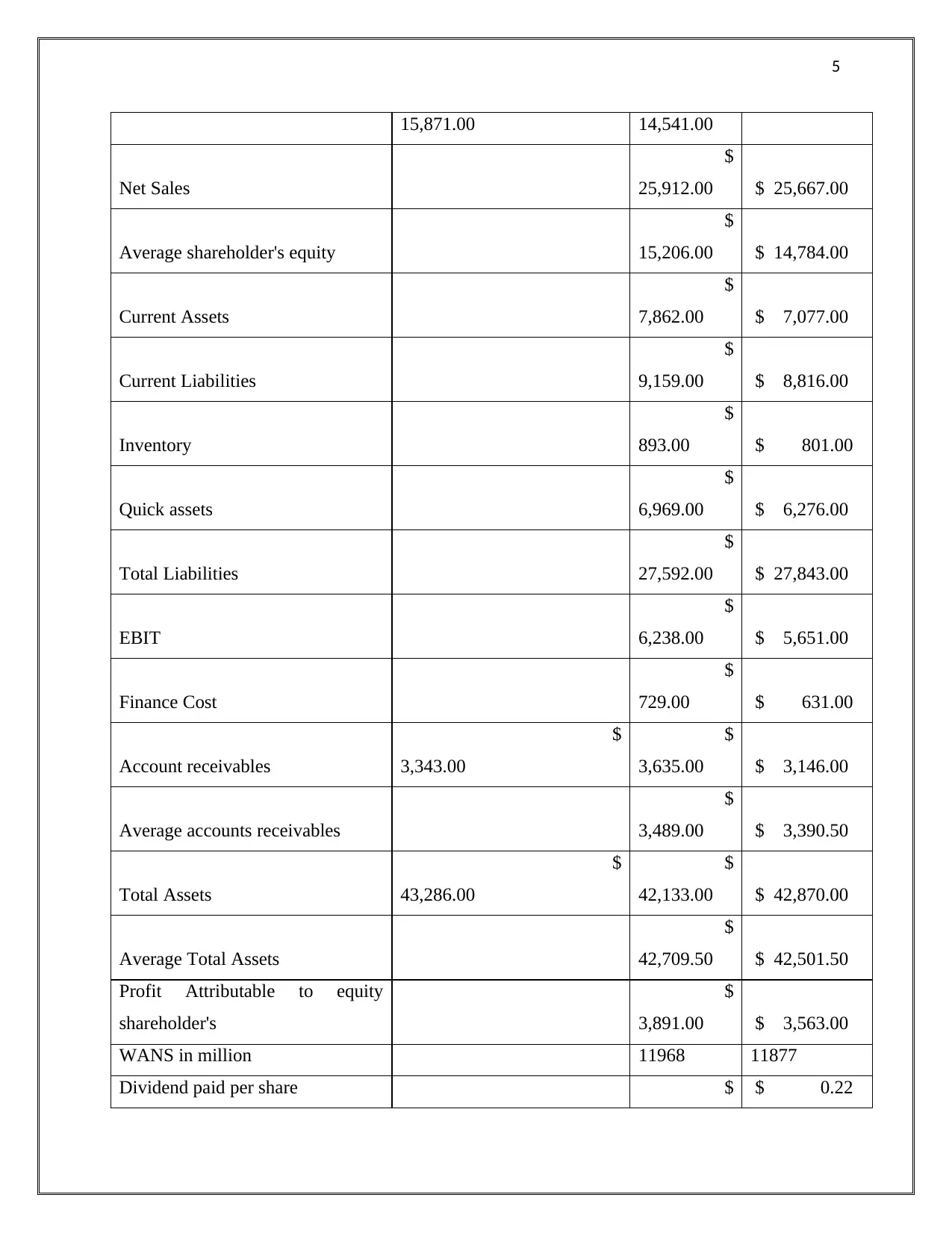
5
15,871.00 14,541.00
Net Sales
$
25,912.00 $ 25,667.00
Average shareholder's equity
$
15,206.00 $ 14,784.00
Current Assets
$
7,862.00 $ 7,077.00
Current Liabilities
$
9,159.00 $ 8,816.00
Inventory
$
893.00 $ 801.00
Quick assets
$
6,969.00 $ 6,276.00
Total Liabilities
$
27,592.00 $ 27,843.00
EBIT
$
6,238.00 $ 5,651.00
Finance Cost
$
729.00 $ 631.00
Account receivables
$
3,343.00
$
3,635.00 $ 3,146.00
Average accounts receivables
$
3,489.00 $ 3,390.50
Total Assets
$
43,286.00
$
42,133.00 $ 42,870.00
Average Total Assets
$
42,709.50 $ 42,501.50
Profit Attributable to equity
shareholder's
$
3,891.00 $ 3,563.00
WANS in million 11968 11877
Dividend paid per share $ $ 0.22
15,871.00 14,541.00
Net Sales
$
25,912.00 $ 25,667.00
Average shareholder's equity
$
15,206.00 $ 14,784.00
Current Assets
$
7,862.00 $ 7,077.00
Current Liabilities
$
9,159.00 $ 8,816.00
Inventory
$
893.00 $ 801.00
Quick assets
$
6,969.00 $ 6,276.00
Total Liabilities
$
27,592.00 $ 27,843.00
EBIT
$
6,238.00 $ 5,651.00
Finance Cost
$
729.00 $ 631.00
Account receivables
$
3,343.00
$
3,635.00 $ 3,146.00
Average accounts receivables
$
3,489.00 $ 3,390.50
Total Assets
$
43,286.00
$
42,133.00 $ 42,870.00
Average Total Assets
$
42,709.50 $ 42,501.50
Profit Attributable to equity
shareholder's
$
3,891.00 $ 3,563.00
WANS in million 11968 11877
Dividend paid per share $ $ 0.22
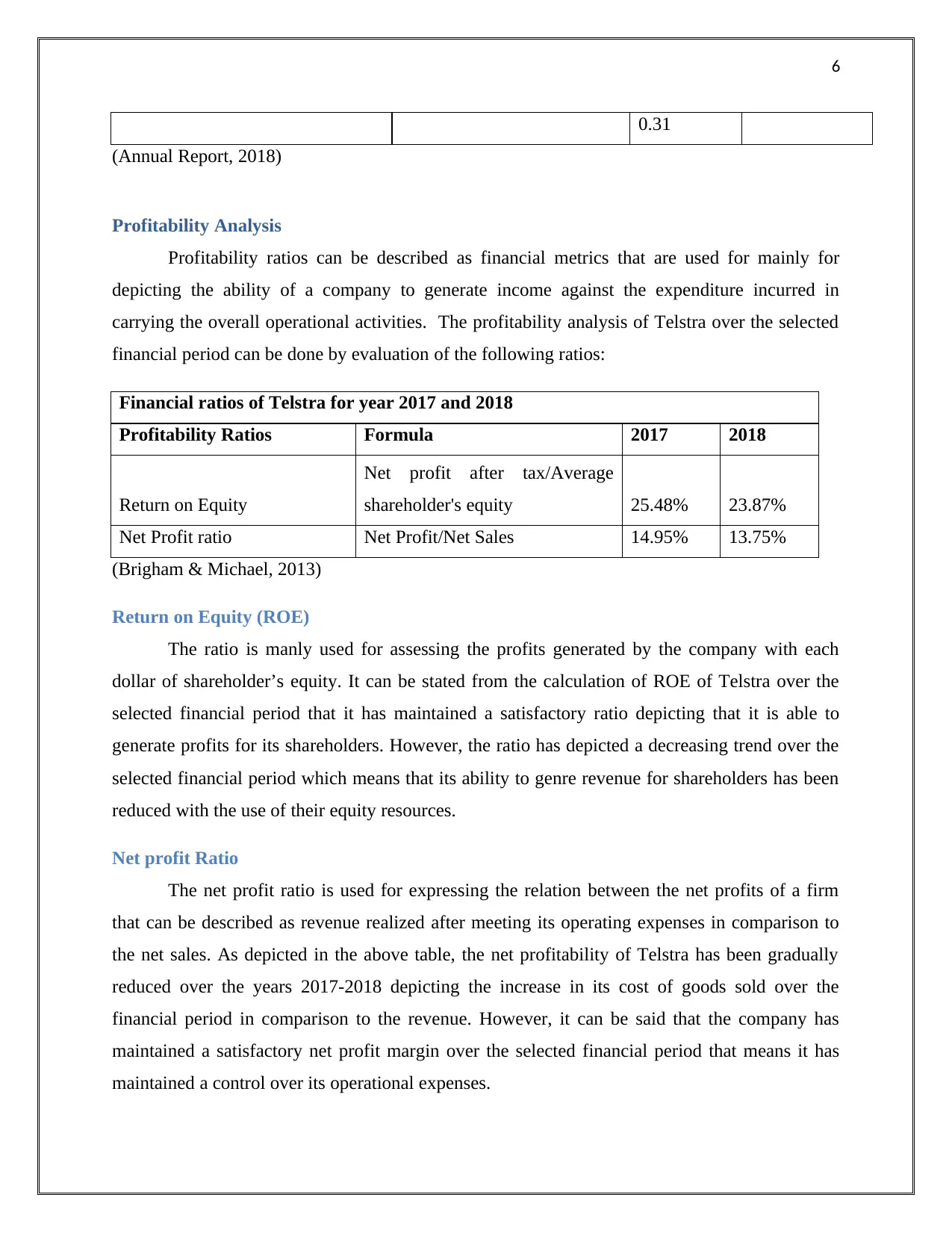
6
0.31
(Annual Report, 2018)
Profitability Analysis
Profitability ratios can be described as financial metrics that are used for mainly for
depicting the ability of a company to generate income against the expenditure incurred in
carrying the overall operational activities. The profitability analysis of Telstra over the selected
financial period can be done by evaluation of the following ratios:
Financial ratios of Telstra for year 2017 and 2018
Profitability Ratios Formula 2017 2018
Return on Equity
Net profit after tax/Average
shareholder's equity 25.48% 23.87%
Net Profit ratio Net Profit/Net Sales 14.95% 13.75%
(Brigham & Michael, 2013)
Return on Equity (ROE)
The ratio is manly used for assessing the profits generated by the company with each
dollar of shareholder’s equity. It can be stated from the calculation of ROE of Telstra over the
selected financial period that it has maintained a satisfactory ratio depicting that it is able to
generate profits for its shareholders. However, the ratio has depicted a decreasing trend over the
selected financial period which means that its ability to genre revenue for shareholders has been
reduced with the use of their equity resources.
Net profit Ratio
The net profit ratio is used for expressing the relation between the net profits of a firm
that can be described as revenue realized after meeting its operating expenses in comparison to
the net sales. As depicted in the above table, the net profitability of Telstra has been gradually
reduced over the years 2017-2018 depicting the increase in its cost of goods sold over the
financial period in comparison to the revenue. However, it can be said that the company has
maintained a satisfactory net profit margin over the selected financial period that means it has
maintained a control over its operational expenses.
0.31
(Annual Report, 2018)
Profitability Analysis
Profitability ratios can be described as financial metrics that are used for mainly for
depicting the ability of a company to generate income against the expenditure incurred in
carrying the overall operational activities. The profitability analysis of Telstra over the selected
financial period can be done by evaluation of the following ratios:
Financial ratios of Telstra for year 2017 and 2018
Profitability Ratios Formula 2017 2018
Return on Equity
Net profit after tax/Average
shareholder's equity 25.48% 23.87%
Net Profit ratio Net Profit/Net Sales 14.95% 13.75%
(Brigham & Michael, 2013)
Return on Equity (ROE)
The ratio is manly used for assessing the profits generated by the company with each
dollar of shareholder’s equity. It can be stated from the calculation of ROE of Telstra over the
selected financial period that it has maintained a satisfactory ratio depicting that it is able to
generate profits for its shareholders. However, the ratio has depicted a decreasing trend over the
selected financial period which means that its ability to genre revenue for shareholders has been
reduced with the use of their equity resources.
Net profit Ratio
The net profit ratio is used for expressing the relation between the net profits of a firm
that can be described as revenue realized after meeting its operating expenses in comparison to
the net sales. As depicted in the above table, the net profitability of Telstra has been gradually
reduced over the years 2017-2018 depicting the increase in its cost of goods sold over the
financial period in comparison to the revenue. However, it can be said that the company has
maintained a satisfactory net profit margin over the selected financial period that means it has
maintained a control over its operational expenses.
⊘ This is a preview!⊘
Do you want full access?
Subscribe today to unlock all pages.

Trusted by 1+ million students worldwide
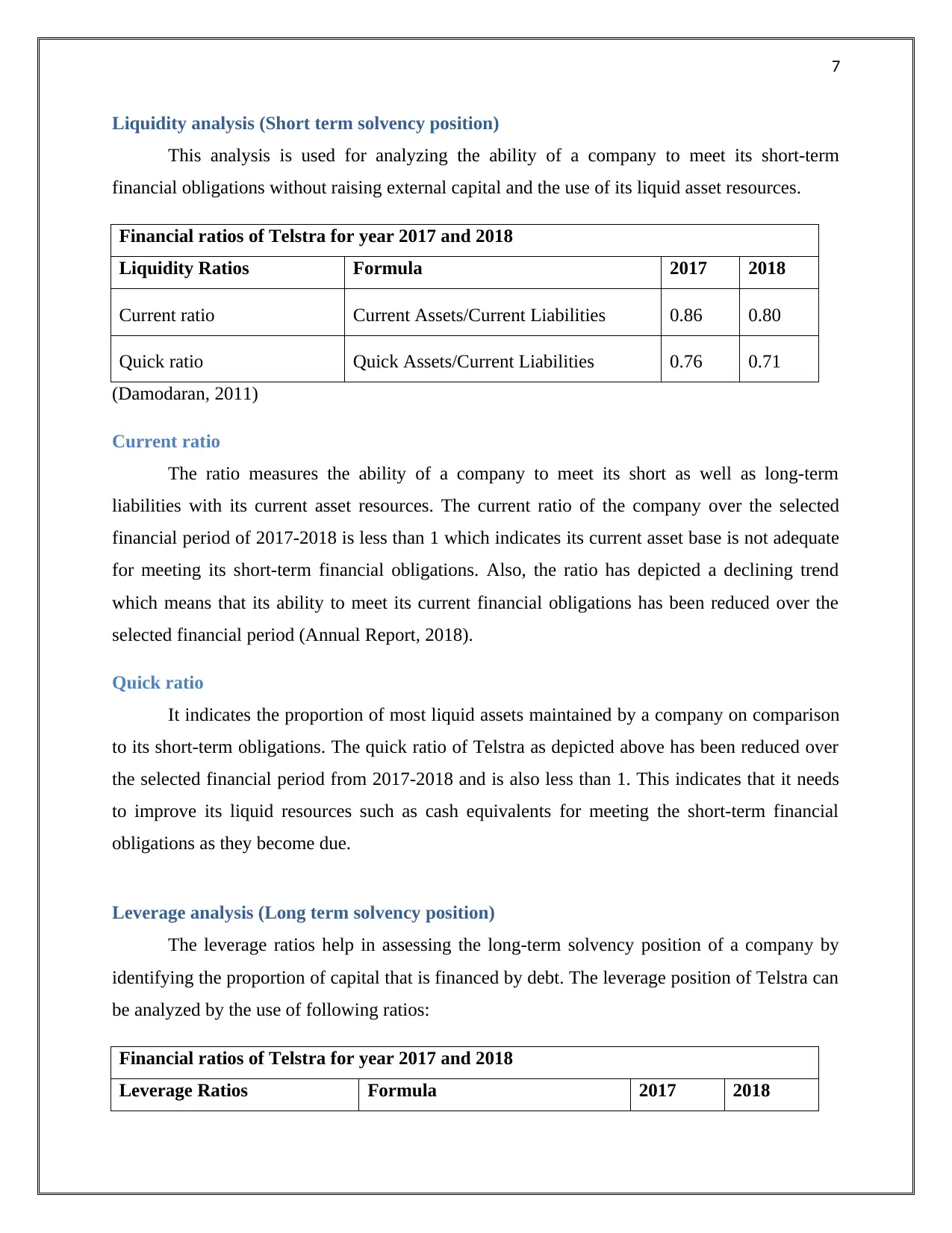
7
Liquidity analysis (Short term solvency position)
This analysis is used for analyzing the ability of a company to meet its short-term
financial obligations without raising external capital and the use of its liquid asset resources.
Financial ratios of Telstra for year 2017 and 2018
Liquidity Ratios Formula 2017 2018
Current ratio Current Assets/Current Liabilities 0.86 0.80
Quick ratio Quick Assets/Current Liabilities 0.76 0.71
(Damodaran, 2011)
Current ratio
The ratio measures the ability of a company to meet its short as well as long-term
liabilities with its current asset resources. The current ratio of the company over the selected
financial period of 2017-2018 is less than 1 which indicates its current asset base is not adequate
for meeting its short-term financial obligations. Also, the ratio has depicted a declining trend
which means that its ability to meet its current financial obligations has been reduced over the
selected financial period (Annual Report, 2018).
Quick ratio
It indicates the proportion of most liquid assets maintained by a company on comparison
to its short-term obligations. The quick ratio of Telstra as depicted above has been reduced over
the selected financial period from 2017-2018 and is also less than 1. This indicates that it needs
to improve its liquid resources such as cash equivalents for meeting the short-term financial
obligations as they become due.
Leverage analysis (Long term solvency position)
The leverage ratios help in assessing the long-term solvency position of a company by
identifying the proportion of capital that is financed by debt. The leverage position of Telstra can
be analyzed by the use of following ratios:
Financial ratios of Telstra for year 2017 and 2018
Leverage Ratios Formula 2017 2018
Liquidity analysis (Short term solvency position)
This analysis is used for analyzing the ability of a company to meet its short-term
financial obligations without raising external capital and the use of its liquid asset resources.
Financial ratios of Telstra for year 2017 and 2018
Liquidity Ratios Formula 2017 2018
Current ratio Current Assets/Current Liabilities 0.86 0.80
Quick ratio Quick Assets/Current Liabilities 0.76 0.71
(Damodaran, 2011)
Current ratio
The ratio measures the ability of a company to meet its short as well as long-term
liabilities with its current asset resources. The current ratio of the company over the selected
financial period of 2017-2018 is less than 1 which indicates its current asset base is not adequate
for meeting its short-term financial obligations. Also, the ratio has depicted a declining trend
which means that its ability to meet its current financial obligations has been reduced over the
selected financial period (Annual Report, 2018).
Quick ratio
It indicates the proportion of most liquid assets maintained by a company on comparison
to its short-term obligations. The quick ratio of Telstra as depicted above has been reduced over
the selected financial period from 2017-2018 and is also less than 1. This indicates that it needs
to improve its liquid resources such as cash equivalents for meeting the short-term financial
obligations as they become due.
Leverage analysis (Long term solvency position)
The leverage ratios help in assessing the long-term solvency position of a company by
identifying the proportion of capital that is financed by debt. The leverage position of Telstra can
be analyzed by the use of following ratios:
Financial ratios of Telstra for year 2017 and 2018
Leverage Ratios Formula 2017 2018
Paraphrase This Document
Need a fresh take? Get an instant paraphrase of this document with our AI Paraphraser
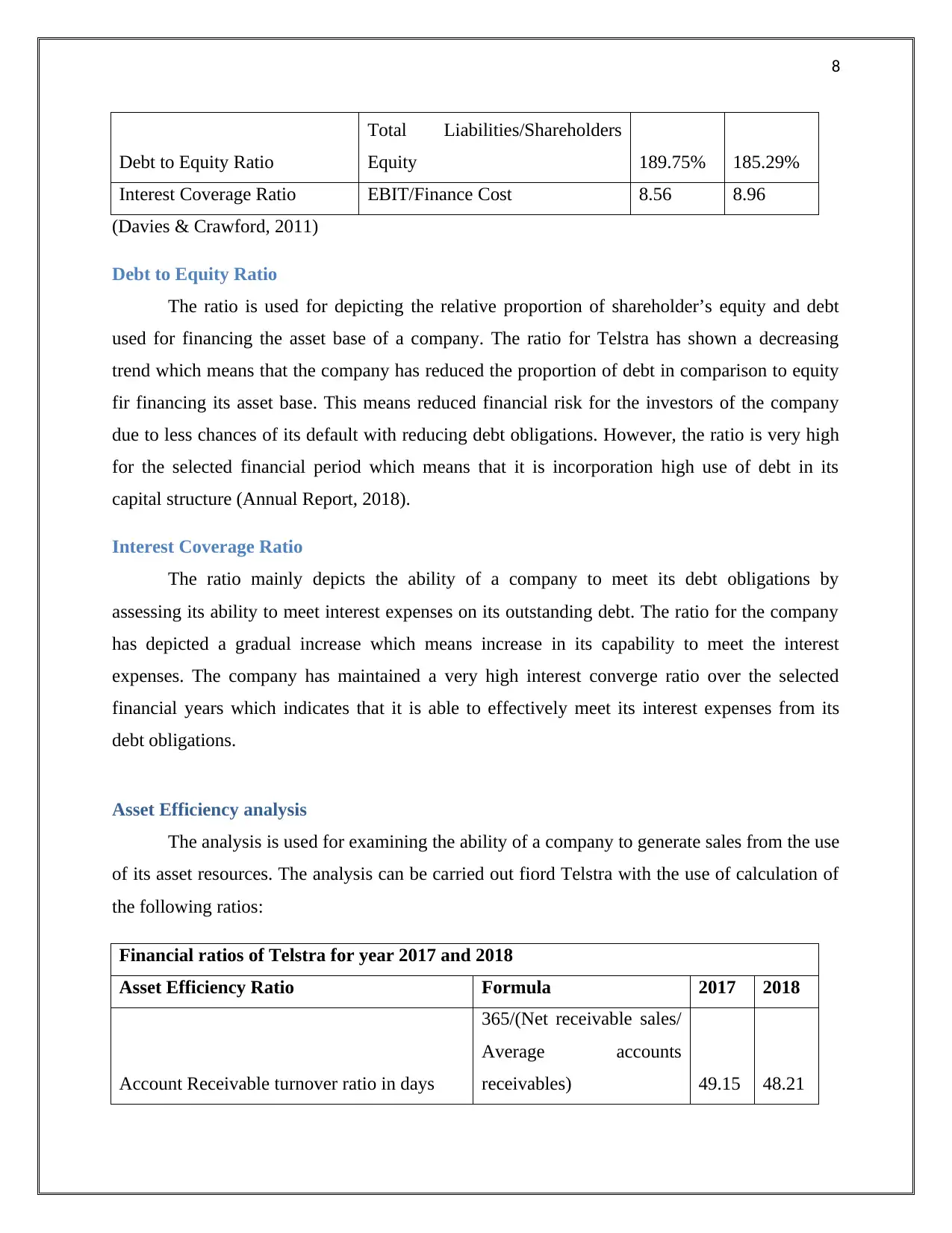
8
Debt to Equity Ratio
Total Liabilities/Shareholders
Equity 189.75% 185.29%
Interest Coverage Ratio EBIT/Finance Cost 8.56 8.96
(Davies & Crawford, 2011)
Debt to Equity Ratio
The ratio is used for depicting the relative proportion of shareholder’s equity and debt
used for financing the asset base of a company. The ratio for Telstra has shown a decreasing
trend which means that the company has reduced the proportion of debt in comparison to equity
fir financing its asset base. This means reduced financial risk for the investors of the company
due to less chances of its default with reducing debt obligations. However, the ratio is very high
for the selected financial period which means that it is incorporation high use of debt in its
capital structure (Annual Report, 2018).
Interest Coverage Ratio
The ratio mainly depicts the ability of a company to meet its debt obligations by
assessing its ability to meet interest expenses on its outstanding debt. The ratio for the company
has depicted a gradual increase which means increase in its capability to meet the interest
expenses. The company has maintained a very high interest converge ratio over the selected
financial years which indicates that it is able to effectively meet its interest expenses from its
debt obligations.
Asset Efficiency analysis
The analysis is used for examining the ability of a company to generate sales from the use
of its asset resources. The analysis can be carried out fiord Telstra with the use of calculation of
the following ratios:
Financial ratios of Telstra for year 2017 and 2018
Asset Efficiency Ratio Formula 2017 2018
Account Receivable turnover ratio in days
365/(Net receivable sales/
Average accounts
receivables) 49.15 48.21
Debt to Equity Ratio
Total Liabilities/Shareholders
Equity 189.75% 185.29%
Interest Coverage Ratio EBIT/Finance Cost 8.56 8.96
(Davies & Crawford, 2011)
Debt to Equity Ratio
The ratio is used for depicting the relative proportion of shareholder’s equity and debt
used for financing the asset base of a company. The ratio for Telstra has shown a decreasing
trend which means that the company has reduced the proportion of debt in comparison to equity
fir financing its asset base. This means reduced financial risk for the investors of the company
due to less chances of its default with reducing debt obligations. However, the ratio is very high
for the selected financial period which means that it is incorporation high use of debt in its
capital structure (Annual Report, 2018).
Interest Coverage Ratio
The ratio mainly depicts the ability of a company to meet its debt obligations by
assessing its ability to meet interest expenses on its outstanding debt. The ratio for the company
has depicted a gradual increase which means increase in its capability to meet the interest
expenses. The company has maintained a very high interest converge ratio over the selected
financial years which indicates that it is able to effectively meet its interest expenses from its
debt obligations.
Asset Efficiency analysis
The analysis is used for examining the ability of a company to generate sales from the use
of its asset resources. The analysis can be carried out fiord Telstra with the use of calculation of
the following ratios:
Financial ratios of Telstra for year 2017 and 2018
Asset Efficiency Ratio Formula 2017 2018
Account Receivable turnover ratio in days
365/(Net receivable sales/
Average accounts
receivables) 49.15 48.21
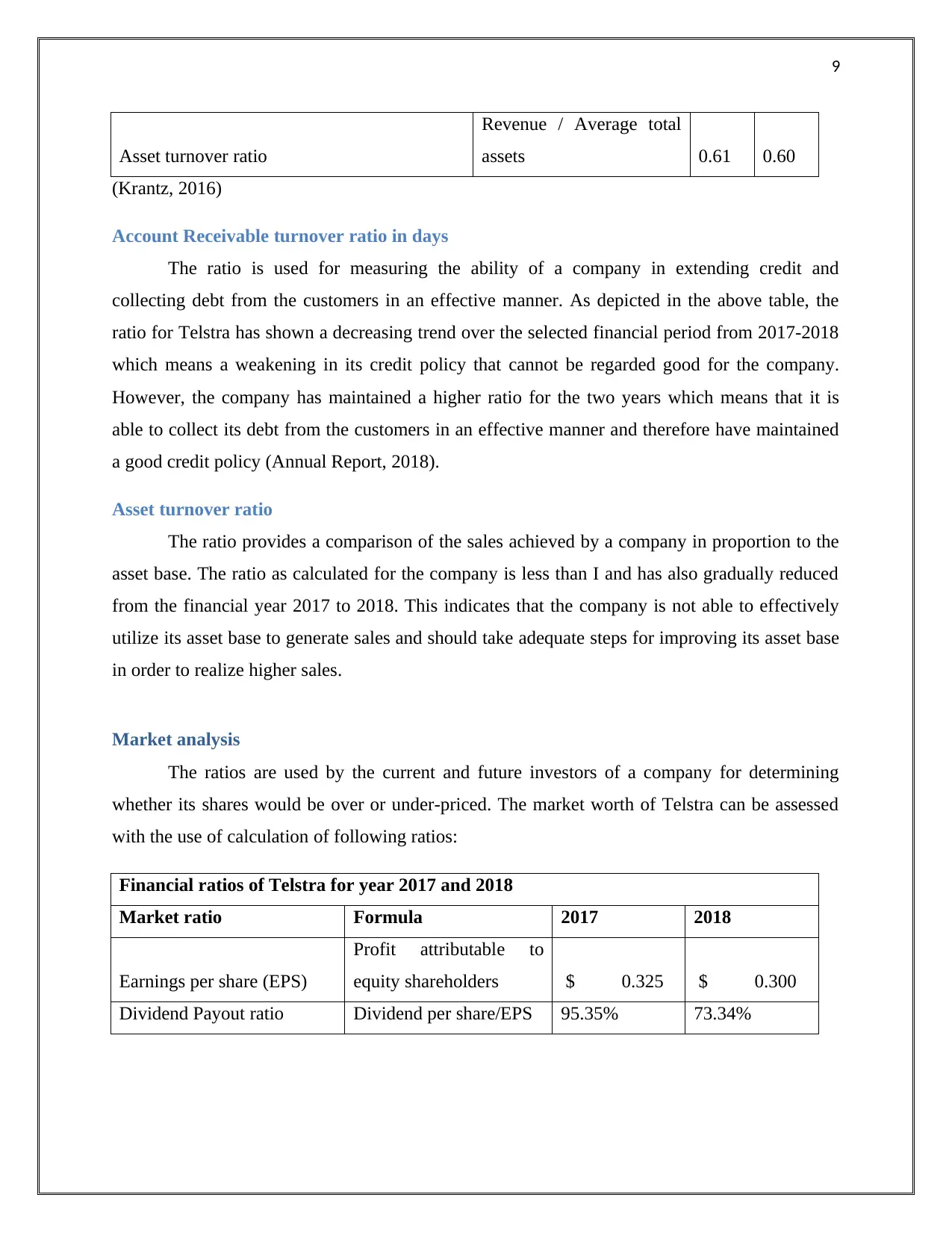
9
Asset turnover ratio
Revenue / Average total
assets 0.61 0.60
(Krantz, 2016)
Account Receivable turnover ratio in days
The ratio is used for measuring the ability of a company in extending credit and
collecting debt from the customers in an effective manner. As depicted in the above table, the
ratio for Telstra has shown a decreasing trend over the selected financial period from 2017-2018
which means a weakening in its credit policy that cannot be regarded good for the company.
However, the company has maintained a higher ratio for the two years which means that it is
able to collect its debt from the customers in an effective manner and therefore have maintained
a good credit policy (Annual Report, 2018).
Asset turnover ratio
The ratio provides a comparison of the sales achieved by a company in proportion to the
asset base. The ratio as calculated for the company is less than I and has also gradually reduced
from the financial year 2017 to 2018. This indicates that the company is not able to effectively
utilize its asset base to generate sales and should take adequate steps for improving its asset base
in order to realize higher sales.
Market analysis
The ratios are used by the current and future investors of a company for determining
whether its shares would be over or under-priced. The market worth of Telstra can be assessed
with the use of calculation of following ratios:
Financial ratios of Telstra for year 2017 and 2018
Market ratio Formula 2017 2018
Earnings per share (EPS)
Profit attributable to
equity shareholders $ 0.325 $ 0.300
Dividend Payout ratio Dividend per share/EPS 95.35% 73.34%
Asset turnover ratio
Revenue / Average total
assets 0.61 0.60
(Krantz, 2016)
Account Receivable turnover ratio in days
The ratio is used for measuring the ability of a company in extending credit and
collecting debt from the customers in an effective manner. As depicted in the above table, the
ratio for Telstra has shown a decreasing trend over the selected financial period from 2017-2018
which means a weakening in its credit policy that cannot be regarded good for the company.
However, the company has maintained a higher ratio for the two years which means that it is
able to collect its debt from the customers in an effective manner and therefore have maintained
a good credit policy (Annual Report, 2018).
Asset turnover ratio
The ratio provides a comparison of the sales achieved by a company in proportion to the
asset base. The ratio as calculated for the company is less than I and has also gradually reduced
from the financial year 2017 to 2018. This indicates that the company is not able to effectively
utilize its asset base to generate sales and should take adequate steps for improving its asset base
in order to realize higher sales.
Market analysis
The ratios are used by the current and future investors of a company for determining
whether its shares would be over or under-priced. The market worth of Telstra can be assessed
with the use of calculation of following ratios:
Financial ratios of Telstra for year 2017 and 2018
Market ratio Formula 2017 2018
Earnings per share (EPS)
Profit attributable to
equity shareholders $ 0.325 $ 0.300
Dividend Payout ratio Dividend per share/EPS 95.35% 73.34%
⊘ This is a preview!⊘
Do you want full access?
Subscribe today to unlock all pages.

Trusted by 1+ million students worldwide
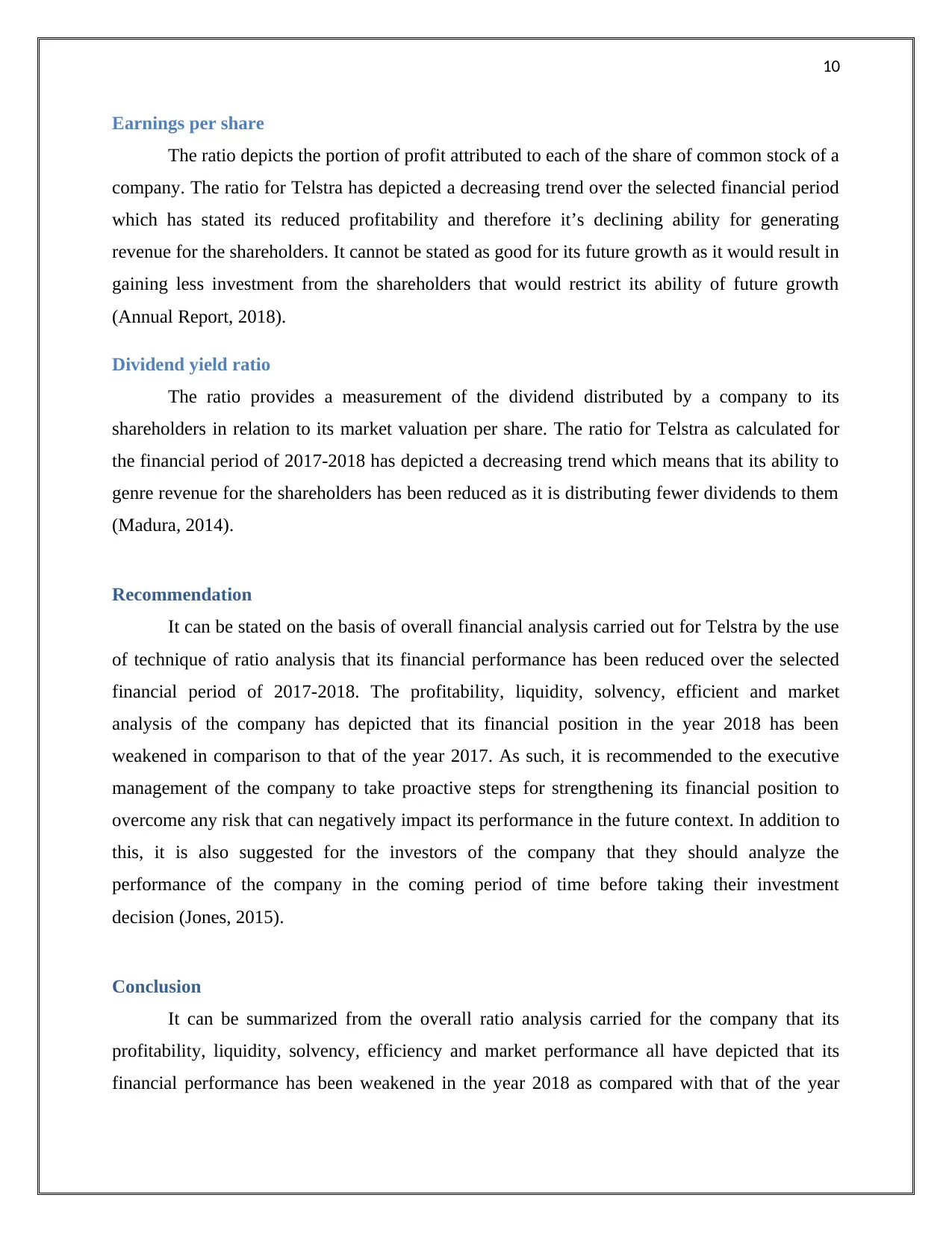
10
Earnings per share
The ratio depicts the portion of profit attributed to each of the share of common stock of a
company. The ratio for Telstra has depicted a decreasing trend over the selected financial period
which has stated its reduced profitability and therefore it’s declining ability for generating
revenue for the shareholders. It cannot be stated as good for its future growth as it would result in
gaining less investment from the shareholders that would restrict its ability of future growth
(Annual Report, 2018).
Dividend yield ratio
The ratio provides a measurement of the dividend distributed by a company to its
shareholders in relation to its market valuation per share. The ratio for Telstra as calculated for
the financial period of 2017-2018 has depicted a decreasing trend which means that its ability to
genre revenue for the shareholders has been reduced as it is distributing fewer dividends to them
(Madura, 2014).
Recommendation
It can be stated on the basis of overall financial analysis carried out for Telstra by the use
of technique of ratio analysis that its financial performance has been reduced over the selected
financial period of 2017-2018. The profitability, liquidity, solvency, efficient and market
analysis of the company has depicted that its financial position in the year 2018 has been
weakened in comparison to that of the year 2017. As such, it is recommended to the executive
management of the company to take proactive steps for strengthening its financial position to
overcome any risk that can negatively impact its performance in the future context. In addition to
this, it is also suggested for the investors of the company that they should analyze the
performance of the company in the coming period of time before taking their investment
decision (Jones, 2015).
Conclusion
It can be summarized from the overall ratio analysis carried for the company that its
profitability, liquidity, solvency, efficiency and market performance all have depicted that its
financial performance has been weakened in the year 2018 as compared with that of the year
Earnings per share
The ratio depicts the portion of profit attributed to each of the share of common stock of a
company. The ratio for Telstra has depicted a decreasing trend over the selected financial period
which has stated its reduced profitability and therefore it’s declining ability for generating
revenue for the shareholders. It cannot be stated as good for its future growth as it would result in
gaining less investment from the shareholders that would restrict its ability of future growth
(Annual Report, 2018).
Dividend yield ratio
The ratio provides a measurement of the dividend distributed by a company to its
shareholders in relation to its market valuation per share. The ratio for Telstra as calculated for
the financial period of 2017-2018 has depicted a decreasing trend which means that its ability to
genre revenue for the shareholders has been reduced as it is distributing fewer dividends to them
(Madura, 2014).
Recommendation
It can be stated on the basis of overall financial analysis carried out for Telstra by the use
of technique of ratio analysis that its financial performance has been reduced over the selected
financial period of 2017-2018. The profitability, liquidity, solvency, efficient and market
analysis of the company has depicted that its financial position in the year 2018 has been
weakened in comparison to that of the year 2017. As such, it is recommended to the executive
management of the company to take proactive steps for strengthening its financial position to
overcome any risk that can negatively impact its performance in the future context. In addition to
this, it is also suggested for the investors of the company that they should analyze the
performance of the company in the coming period of time before taking their investment
decision (Jones, 2015).
Conclusion
It can be summarized from the overall ratio analysis carried for the company that its
profitability, liquidity, solvency, efficiency and market performance all have depicted that its
financial performance has been weakened in the year 2018 as compared with that of the year
Paraphrase This Document
Need a fresh take? Get an instant paraphrase of this document with our AI Paraphraser

11
2017. The Board of the company should identify and take proactive measures for overcoming
these gaps in performance to foster its growth and development in the future context of time.
2017. The Board of the company should identify and take proactive measures for overcoming
these gaps in performance to foster its growth and development in the future context of time.
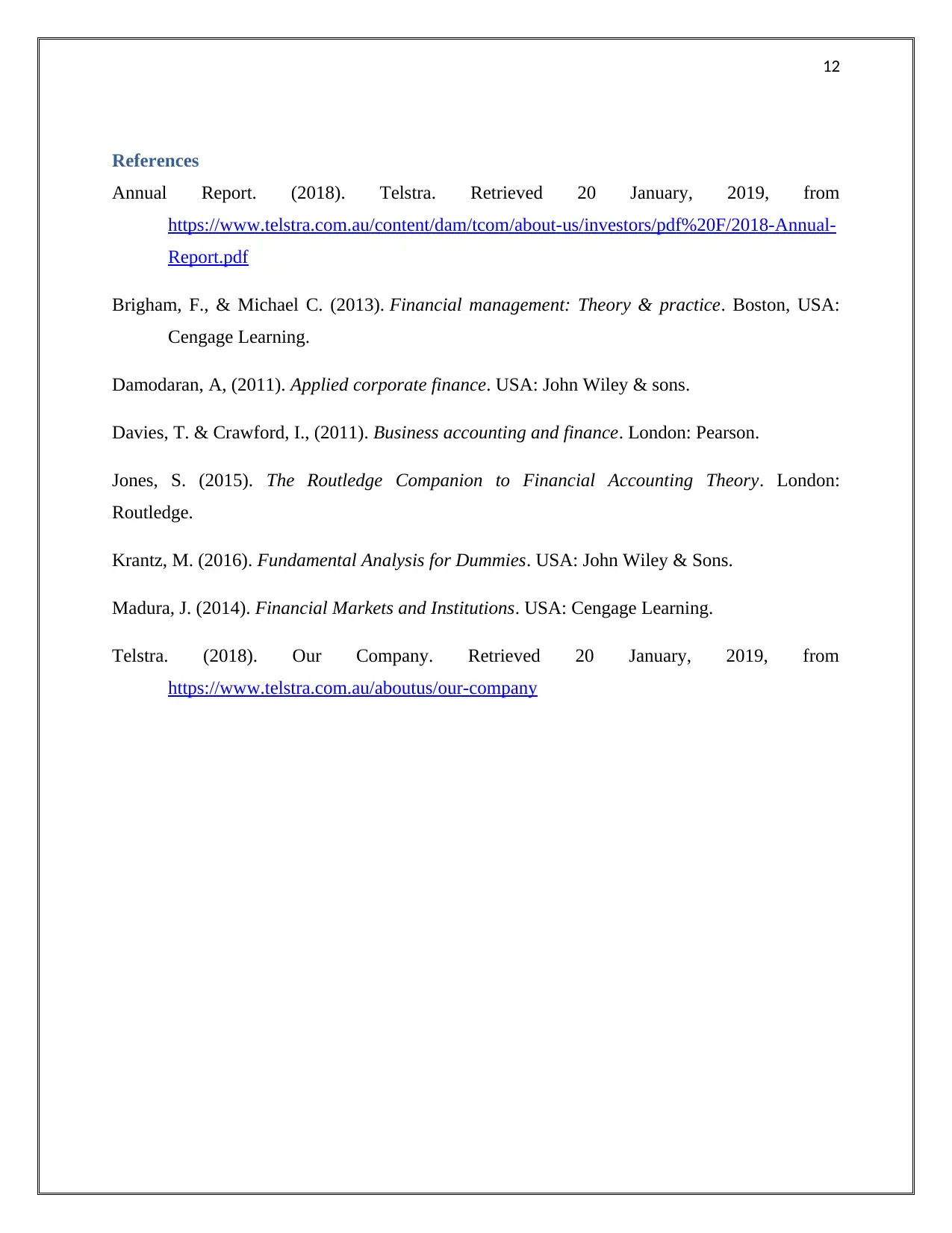
12
References
Annual Report. (2018). Telstra. Retrieved 20 January, 2019, from
https://www.telstra.com.au/content/dam/tcom/about-us/investors/pdf%20F/2018-Annual-
Report.pdf
Brigham, F., & Michael C. (2013). Financial management: Theory & practice. Boston, USA:
Cengage Learning.
Damodaran, A, (2011). Applied corporate finance. USA: John Wiley & sons.
Davies, T. & Crawford, I., (2011). Business accounting and finance. London: Pearson.
Jones, S. (2015). The Routledge Companion to Financial Accounting Theory. London:
Routledge.
Krantz, M. (2016). Fundamental Analysis for Dummies. USA: John Wiley & Sons.
Madura, J. (2014). Financial Markets and Institutions. USA: Cengage Learning.
Telstra. (2018). Our Company. Retrieved 20 January, 2019, from
https://www.telstra.com.au/aboutus/our-company
References
Annual Report. (2018). Telstra. Retrieved 20 January, 2019, from
https://www.telstra.com.au/content/dam/tcom/about-us/investors/pdf%20F/2018-Annual-
Report.pdf
Brigham, F., & Michael C. (2013). Financial management: Theory & practice. Boston, USA:
Cengage Learning.
Damodaran, A, (2011). Applied corporate finance. USA: John Wiley & sons.
Davies, T. & Crawford, I., (2011). Business accounting and finance. London: Pearson.
Jones, S. (2015). The Routledge Companion to Financial Accounting Theory. London:
Routledge.
Krantz, M. (2016). Fundamental Analysis for Dummies. USA: John Wiley & Sons.
Madura, J. (2014). Financial Markets and Institutions. USA: Cengage Learning.
Telstra. (2018). Our Company. Retrieved 20 January, 2019, from
https://www.telstra.com.au/aboutus/our-company
⊘ This is a preview!⊘
Do you want full access?
Subscribe today to unlock all pages.

Trusted by 1+ million students worldwide
1 out of 12
Related Documents
Your All-in-One AI-Powered Toolkit for Academic Success.
+13062052269
info@desklib.com
Available 24*7 on WhatsApp / Email
![[object Object]](/_next/static/media/star-bottom.7253800d.svg)
Unlock your academic potential
© 2024 | Zucol Services PVT LTD | All rights reserved.





